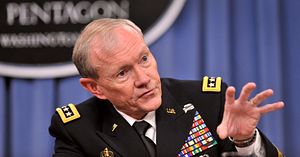On Sunday, Afghan President Ashraf Ghani and the United States’ outgoing Chairman of the Joint Chiefs of Staff General Martin Dempsey met to discuss the rising threat of the Islamic State in Afghanistan. Specifically, Dempsey spoke with Ghani about a joint U.S.-Afghan strategy to counter the Islamic State group’s rise in the country which has become increasingly violent as U.S. troops began withdrawing at the end of 2014. According to the U.S. Department of Defense, Dempsey and Ghani discussed “the possibility of forming a network to oppose the transregional threat posed by the Islamic State of Iraq and the Levant.”
“I think we’re all having an important discussion on how to address the transregional nature of what is clearly a persistent threat that has to be addressed at a sustainable level of effort over a period of time,” Dempsey told reporters. He has emphasized the need for a trans-national and trans-regional strategy to counter the spreading influence of the Islamic State. Dempsey summarized Ghani’s view on the issue: “His view is: ‘Hey, look, I’m a willing partner in an area where you may not have willing partners,’” he told reporters.
For the moment, the Obama administration hasn’t quite figured out just how the sudden “rise” of the Islamic State in Afghanistan—if it can be called that—will address the broader U.S. withdrawal plan. Per the Bilateral Security Agreement between the United States and Afghanistan, only a small contingent of U.S. troops would stay behind to train their Afghan counterparts and engage in limited counter-terrorism operations. A broader effort to counter the Islamic State could require a recalibration of this plan.
In Dempsey’s estimation, the Islamic State’s presence in Afghanistan is at an early stage, leaving some space for the United States and Afghan governments to come to a strategy. “In Iraq and Syria, you might say they are in stage 6 or 7 or 8,” he said. “In Libya, they are in stage 3 or 4, and in Afghanistan they are in stage 1 or 2,” Dempsey remarked. The nightmare scenario for the Obama administration is a scenario where the Islamic State and the Taliban are engaged in an all-out struggle with a frail Afghan government attempting to retain control in the background. General John Campbell, the top U.S. commander, noted on Sunday that the Islamic State has gone from being “nascent” in Afghanistan to “operationally emergent.”
For the Afghan government, the Islamic State poses a unique threat, different from that posed by the Taliban. Where the Taliban seeks to overthrow an Afghan state that it sees as illegitimate and establish an Islamic Emirate in Afghanistan, fighters affiliated with the Islamic State in the country—many of whom were previously rank-and-file members of the Pakistani and Afghan Taliban—seek to control territory for a trans-national caliphate led by Abu Bakr al-Baghdadi in Iraq.
As a result of these conflicting objectives, the two groups are opposed to each other and, starting earlier this year, began discussing their differences publicly. For example, after the Islamic State claimed responsibility a deadly suicide attack in Jalalabad earlier this year, a Taliban-affiliated group noted that the “people who carried out this act have nothing to do with Islam and Muslims. Bombing at public places is a conspiracy to defame the mujahideen. We consider bleeding of any Muslim unjustified.”
In January 2015, the Islamic State announced the formation of a Khorasan Shura—a council of leaders to oversee the group’s operations in the area roughly comprising the modern day states of Pakistan and Afghanistan. The Shura comprised several senior leaders from the Tehreek-e-Taliban Pakistan (TTP), the Pakistani manifestation of the Taliban. As I noted last month, the Taliban has grown frustrated with the Islamic State’s activities in Afghanistan; the group released a statement noting that “The Islamic Emirate [of Afghanistan] does not consider the multiplicity of jihadi ranks beneficial either for jihad or for Muslims.” It continued: “Your decisions made from a distance will result in [the Islamic State] losing support of religious scholars, mujahideen… and in order to defend its achievements the Islamic Emirate will be forced to react.”
In late June, reports emerged that the Islamic State and the Taliban were engaging in all-out skirmishes over territorial control, particularly in eastern Afghanistan. One Reuters report detailed the seizure of “substantial territory” by fighters loyal to the Islamic State, who reportedly fought Taliban loyalists with pickup truck technicals. The reports suggested a degree of tactical sophistication to these fighters, many of whom were likely Taliban fighters in the past.
Overall, the Taliban remains by far the more powerful and threatening to Afghan stability of the two groups. With a fragile peace process back on in recent months—with Chinese and Pakistani cooperation to an extent—the U.S. and Afghan governments should keep their eyes on the broader picture in Afghanistan. For the moment, there is no guarantee that the Islamic State will be able to reproduce the same sort of territorial control that it exercises in the Levant in Afghanistan.

































